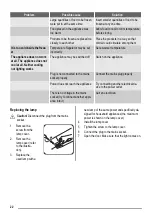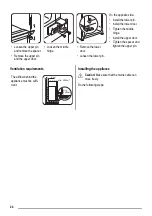
Thawing
Deep-frozen or frozen food, prior to being used, can be
thawed in the refrigerator compartment or at room tem-
perature, depending on the time available for this oper-
ation.
Small pieces may even be cooked still frozen, directly
from the freezer: in this case, cooking will take longer.
Ice-cube production
This appliance is equipped with one or more trays for
the production of ice-cubes. Fill these trays with water,
then put them in the freezer compartment.
Important!
Do not use metallic instruments to remove
the trays from the freezer.
Movable shelves
The walls of the refrigera-
tor are equipped with a
series of runners so that
the shelves can be posi-
tioned as desired.
Positioning the door shelves
To permit storage of food
packages of various
sizes, the door shelves
can be placed at different
heights.
To make these adjust-
ments proceed as fol-
lows:
gradually pull the shelf in
the direction of the ar-
rows until it comes free,
then reposition as re-
quired.
Helpful hints and tips
Hints for energy saving
• Do not open the door frequently or leave it open lon-
ger than absolutely necessary.
• If the ambient temperature is high and the Tempera-
ture Regulator is set to low temperature and the ap-
pliance is fully loaded, the compressor may run con-
tinuously, causing frost or ice on the evaporator. If
this happens, set the Temperature Regulator toward
warmer settings to allow automatic defrosting and so
a saving in electricity consumption.
Hints for fresh food refrigeration
To obtain the best performance:
• do not store warm food or evaporating liquids in the
refrigerator
• do cover or wrap the food, particularly if it has a
strong flavour
• position food so that air can circulate freely around it
Hints for refrigeration
Useful hints:
Meat (all types) : wrap in polythene bags and place on
the glass shelf above the vegetable drawer.
For safety, store in this way only one or two days at the
most.
Cooked foods, cold dishes, etc..: these should be cov-
ered and may be placed on any shelf.
Fruit and vegetables: these should be thoroughly
cleaned and placed in the special drawer(s) provided.
Butter and cheese: these should be placed in special
airtight containers or wrapped in aluminium foil or poly-
thene bags to exclude as much air as possible.
Milk bottles: these should have a cap and should be
stored in the bottle rack on the door.
Bananas, potatoes, onions and garlic, if not packed,
must not be kept in the refrigerator.
18
















































